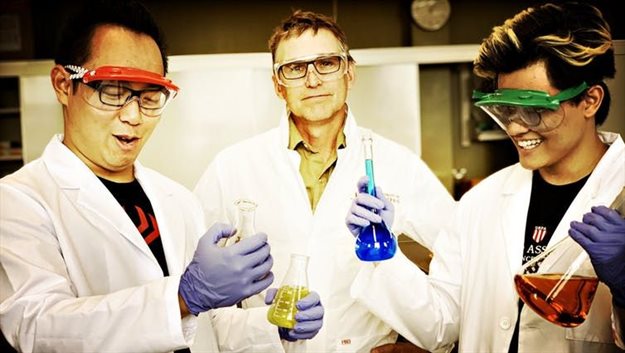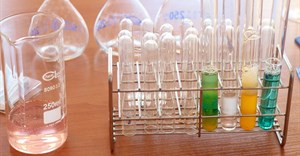
Green chemistry labs teach students a sustainable and innovative mindset

These principles are are now widely touted as the solution to making chemistry a field that develops more sustainably. Today’s chemistry students expect to be educated with environmental impact in mind. Chemistry education researcher Julie Haack at the University of Oregon notes that laboratory methods leading to greener results are critical for how chemistry educators equip chemists for today and the future.
As a chemistry faculty member and researcher of green chemistry education at the University of Winnipeg, with my colleague Michael Weibe I’ve found there are multiple benefits to developing new experiments that incorporate the principles and metrics of green chemistry.
When students practice green chemistry, they learn to think critically about the global impact of their field — and fortuitously, they also become passionate about closely studying the principles and techniques involved in chemical transformation.
By comparatively introducing the principles and metrics of green chemistry to undergraduates, instructors can ingrain consideration of green chemistry principles and metrics into prospective chemists’ daily routines. They can challenge chemists-in-training to always look for alternative routes, and inspire meaningful and purposeful curiosity.

Hazardous chemicals
For example, in the following lesson, students can learn that a seemingly small development in how chemists choose to synthesize chemicals could mean keeping mass volumes of hazardous chemicals out of the waste stream at the industrial level.
A reaction called a nucleophilic aromatic substitution is an example of a lab experiment that undergraduate organic chemistry students can generally accomplish in about an hour.
Pictured below is a schematic representation of this reaction. Chemists working in industry might do this synthesis as one of several steps in producing pharmaceuticals, plastics or textiles.

In this step, the bromine (Br) is simply substituted by an organic nitrogen (N) compound.
Now, the environmental impact resulting from a reaction such as this is not usually the target compound itself (2,4-dinitro-N,N-diethylaniline).
Rather, the related hazards are more likely to be the reagents, solvents and energy that are necessary for the successful transformation. This experiment traditionally uses toluene as a solvent, which is toxic, and requires a catalyst called tetrabutylammonium bromide (TBAB). There’s also the energy necessary to boil toluene for an hour to a high boiling point.
Consider the alternatives
In undergraduate chemistry labs, students quickly learn that developing new processes requires a methodical and committed work ethic. Students come to understand that it could take the practising chemist months or years of time to develop less hazardous routes to the same target molecules.
Developing new, less hazardous, routes may not seem either practical or possible, especially when students consider expectations from external factors like academic supervisors or employers who may not be committed to green chemistry.
Rather than being satisfied with successes from traditional hazardous methods, all chemists should be trained to inspect targets and experiments closely and ask themselves the following questions:
- Could the yield (the amount of product obtained) be increased?
- Why have particular reagents or solvents been used? In the example above, the toxic toluene was used because it’s a high boiling organic solvent appropriate to the high temperature needed for this heat-driven transformation. The TBAB used is a phase transfer catalyst that enables the reaction to occur quicker and with higher yields. But could a more benign solvent system be used, or other steps taken to impact the pace and yield of the experiment?
- How much materials are necessary in forming the end product — and by association, how much end up in waste? For example, chemists can determine the atom economy (AE) of this reaction. A high AE signifies a more sustainable chemical process, whereas a low AE signifies a process with more waste. This step is called determining green chemistry metrics.
In the example above, the Br atom and the TBAB are not in the final product. They end up in the waste stream which decreases the experimental AE of this reaction. Bottom line: it’s less sustainable.
A greener route
With my colleagues, I am developing experimental techniques that incorporate the principles and metrics of green chemistry and also lead to students’ increased interest in looking critically at their lab work and the results.
One example is an experiment which trains students to compare microwave assisted synthesis to the traditional technique of boiling (described above).
Students find that this route is consistently successful in producing the same target molecule as in the more traditional experiment: it leads to the same synthesis and is greener and easier.
Among the other advantages, this method has a five minute reaction time, compared to one hour of boiling, along with a much quicker reaction work-up.
It uses the more benign solvent mixture of ethanol/water (toluene is a neurotoxin and embryotoxin); it has a higher yield and a higher AE, which means less reactants are required for the desired synthesis.

Atom economy
When I have taught this alternate experiment, I found that students immediately understand the benefit of the increased yield and benign solvent mixture. And, the increased AE of the microwave-assisted route spurs important discussions.
This experiment illustrates the opportunity to guide students to explore the environmental impact of the small increase in this green chemistry metric. Instructors can discuss how such an adjustment could play out in applied industrial chemistry: for example, in the US alone, chemical companies are currently producing between 100,000 to 500,000 pounds of TBAB as an intermediate to facilitate production of other compounds.
Removing this one compound from a synthetic route automatically removes all of the reagents, solvents and energy in producing, and disposing of, that same compound.
The apprenticing chemist learns that a research development leading to an increase in atom economy could have a profound environmental impact in an industrial setting.
To change the mindset of the chemical industry from being economically driven to being sustainability driven, scientists must develop new scientific processes that prioritise environmental considerations.
This article is republished from The Conversation under a Creative Commons license. Read the original article.![]()
Source: The Conversation Africa

The Conversation Africa is an independent source of news and views from the academic and research community. Its aim is to promote better understanding of current affairs and complex issues, and allow for a better quality of public discourse and conversation.
Go to: https://theconversation.com/africa










